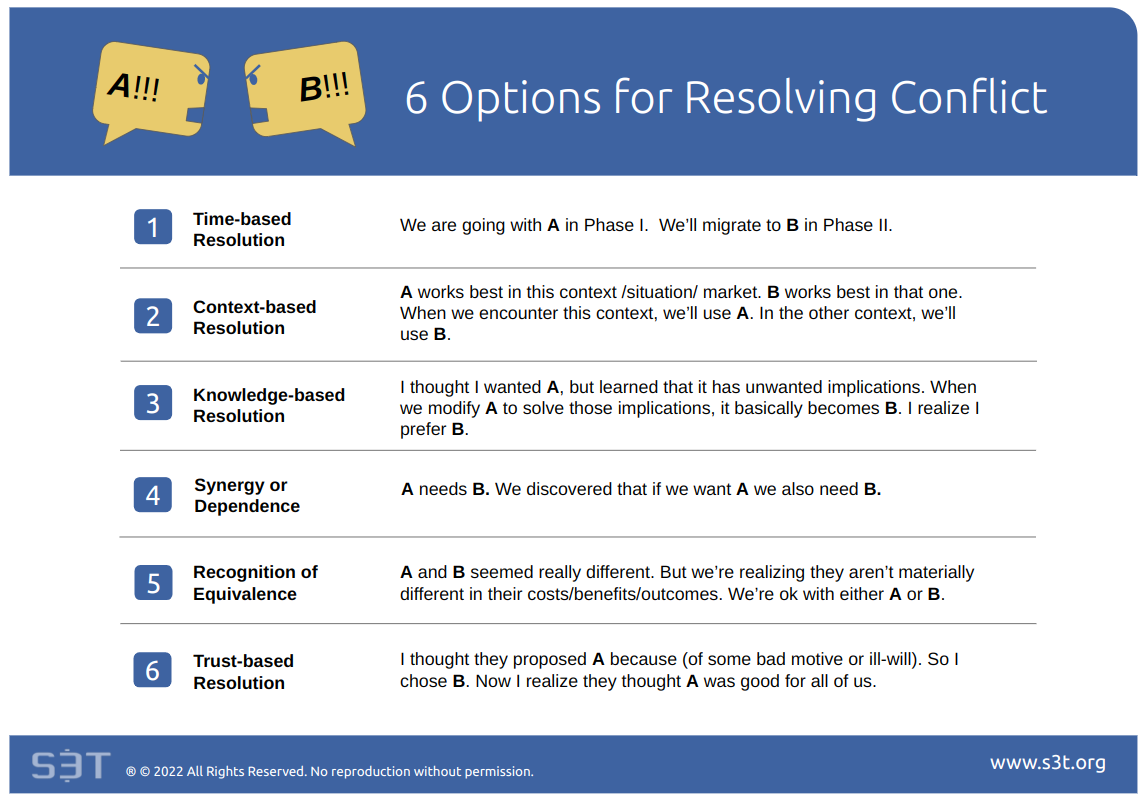📗S3T Playbook: 6 Proven Ways to Resolve Conflicts

In this segment we'll learn a framework of 6 options that you can use to successfully resolve most conflicts. You will probably find that you can resolve probably 90% of conflicts - including conflicts involving resistance to change - by using this set of options.
The handy cheat sheet below summarizes the 6 options:

Roots of Conflict
When you encounter opposing viewpoints you always want to ask: what are these opposing viewpoints rooted in? Many times the conflicts themselves are rooted in different:
- time periods,
- contexts
- knowledge gaps
- assumptions
- different understandings
all of which can actually cause people to hold opposing viewpoints for very valid reasons. In other words, if the situation truly was as they believe it to be, you might actually agree with their position.
When you show your team how to use these options, you'll see a huge difference in progress, collaboration and forward momentum. You can create a culture where the onset of conflict starts to evoke a very different response: instead of everyone tensing up and going into fight or flight mode, everyone takes a more relaxed, more curious mindset.
Like, ok, let's see what our options are for resolving this?
This set of options will help you find agreement in almost any situation. We'll go through each option and explain how and why it works so well.
6 Options for Resolving Conflict
1. Time-Based Resolution
You could also refer to this as Phase based resolutions: recognizing that the both parties are right, in their own times.
Like this:
- In this phase my version of the process etc is the correct version...this is how it’s going to work in this phase,
- But, in the next phase your version will be the correct version
There’s a transition. There’s a certain point in time where the version of the process or the framework or whatever will have to work the way I’m describing it. But it’s going to evolve and then the way you’ve pictured it will be the way it works then. So we agree on a time-based resolution to our conflict, and we commit to working through a transition together.
2. Context-based resolution
This is often relevant for IT or specialist scenarios where people are in conflict people are talking about two different parts of a large complex system or set of organizations. They may not realize that they’re really talking about two separate parts of the system or ecosystem. Or they may be misapplying local expertise that works perfectly well in their own domain, but won't work in another domain or context.
What’s the best way to resolve disconnects this? Diagrams and pictures, even whiteboard drawings can be a huge help. Sit down and go through the details together. Expect conversations like "the (data/security/operations) model you’re talking about...yes that’s how it works in this context you're familiar with, but over here, we don’t need that because we already have this other mitigating provision." Or "Yes, it does work that way in this context, but it actually doesn’t work that way over here." Once the parties start to understand that, then there’s a moment like "OH, ok I didn’t realize that."
Key insight about Context based resolutions: In these cases, parties in conflict are often motivated by fear that a critical objective won't be met, because it appears you're not following the methods they've used in the past to successfully meet that objective. They're worried about failing to meet the objective.
Once they realize:
- you're just as concerned about meeting that objective and
- there's another proven way to meet the objective,
they're more likely to be open to and willing to negotiate.
3. Knowledge-based resolution
In some conflict scenarios, when you zoom in on why they disagree, you find that one party has a knowledge gap. Frequently both parties may have knowledge gaps.
Now, knowledge gaps can take several forms:
- a knowledge gap related to technical knowledge or other domains of expertise.
- a gap in knowledge about a specific cultural context,
- lack of knowledge about specific requirements or criteria.
It's important to put people at ease, establish common ground and mutual respect before attempting to educate or address knowledge gaps. Avoid impatient "we don't have time for this" vibes and fast-talking lectures. Keep in mind you may have a knowledge gap of your own. Slow down if you want to go faster.
4. Synergy or Dependence
This refers to the realization that two apparently opposing options are actually compatible or interdependent. Sometimes options that appear to be mutually exclusive actually are not. Sometimes they have a beneficial synergy. Exploring and being open to this possibility can sometimes yield surprising resolutions.
5. Equivalence
Sometimes what appears to be two different options, can turn out to be roughly equivalent in terms of their costs, benefits, or outcomes. In other words, the difference between one vs the other is not worth fighting about. Giving the teams or opposing parties time to do their due diligence, sometimes with guidance from a neutral party with relevant domain expertise can make all the difference.
6. Trust: Clarification of Intent
Often conflicts arise when one or both parties feel slighted, insulted or threatened by a perceived intention. When a space for reflection and conversation is created, it becomes apparent that the other party never had ill intent.
This is one reason why the S3T Newsletter often features a segment on food, drink and good times. Creating a space to have drink or meal together can foster trust. If you can get people to sit down and eat together, you can probably get them to work together. If you can get them to cook together - they can probably do anything!
To Summarize
So we've just learned 6 great options for resolving conflicts. Keeping these options in mind can help you and your team evaluate a conflict happening in your organization, and decide your best response.
Remember in most cases, conflicts are disconnects that can be resolved if you help people see:
- The different dimensions of the conflict
- The different ways in which sometimes conflicting parties are both right
Often people will come to the realization there’s not really a conflict here.
Click here to go to the next learning segment: Uneven accountability
Innovation and transformation initiatives are often challenged by uneven accountability: one part of the team feels a high degree of ownership and accountability for making the change initiative successful, but must rely on other teams that seem to not feel the same levels of ownership and accountability. Learn how to address this effectively.
